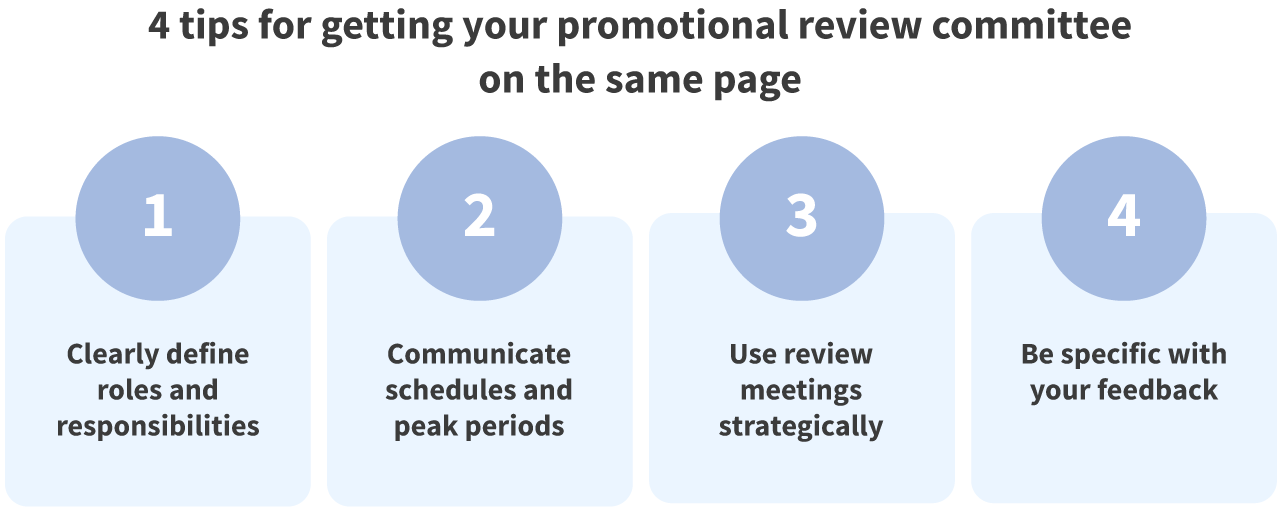Tip #1: Clearly define roles and responsibilities
Knowing who does what is a crucial first step to building an efficient PRC. With roles clearly defined, each department involved in the review process knows exactly what they’re responsible for during content review. It’s also best to document these roles and responsibilities so that everyone on the PRC is on the same page. Example roles and review responsibilities include:
- Regulatory reviewer(s). Review materials for accuracy of content for product claims and to ensure content is truthful and not misleading, as well as fair balanced. The regulatory reviewer is responsible for understanding the strict parameters governing what companies can and can’t say about a drug or product, and what language must appear (especially as regards labeling) in ad/promo materials to ensure compliance with internal and external regulations.
- Medical reviewer(s). Review materials to ensure it is scientifically and medically accurate, with a balanced presentation of safety and efficacy data, consistent with approved labeling and is supported by appropriate statistical analysis. Medical reviewers also ensure content is consistent with medical practices, clinically relevant, has the appropriate level of sophistication for the intended audience, and is not misleading or likely to cause confusion.
Tip #2: Communicate schedules and peak periods
Nobody likes the feeling of missing a deadline or being the bottleneck in a process. Having a well-planned schedule keeps MLR staff from being put in these positions.
Establishing and communicating schedules and deadlines for deliverables enables the team to slate their work accordingly and open up channels of communication around feasibility of workload. When possible, design your MLR process to be independent of specific personnel and consider allowing teams to self-organize tasks.
If you need to utilize meetings to approve a piece of content, schedule those in advance when possible. But as you’ll see next, using review meetings strategically is just as important as timing.
Tip #3: Use review meetings strategically
Teams in general should try to streamline their meetings to prevent employee frustration and a sense of wasting time. For promotional review committees, where time is of the essence and staff may have other responsibilities on their plate, it is especially important to have clear parameters for what meetings – in person or virtual – need to accomplish.
The PRC coordinator/manager should look over the content for discussion and set the agenda accordingly. Brief the MLR team beforehand on what content will be discussed, and have team members review and mark up the content in question beforehand as necessary (which is easier with a cloud-based promotional review system). This organized approach leads to quick and productive meetings that move the process meaningfully forward.
Tip #4: Be specific with your feedback
Being more specific and more direct in all communications can drastically improve PRC collaboration. Every request that confuses a colleague can mean time spent clarifying, backtracking, retracing steps and so on. A few things to keep in mind when you’re emailing or chatting with a colleague are:
- Put requests that need to be handled (i.e., “please change the color of this ad’s background”) at the beginning of an email or chat; don’t make coworkers dig.
- Don’t speak in generalities. For example, don’t just say “let’s use a different photo here,” – give the necessary dimensions, specifications, and reasoning behind the change.
- Make sure you’re clear when a change is suggested vs. when one is required.
Streamlining MLR at every level
A successful MLR process results from individuals, teams, and technology all working together effectively. What exactly that entails can change quickly in today’s life science marketing world. But Vodori is here to provide solutions and best practices, so that you and your MLR review teams are always ready for challenges emerging in this fast-moving space and the regulatory landscape that governs it.
If you’re interested in more best practices for streamlining your operations and improving your PRC, download our eBook – and let the optimal collaboration begin!



